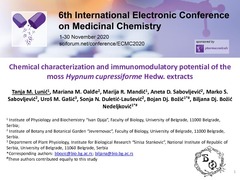Приказ основних података о документу
Chemical characterization and immunomodulatory potential of the moss HypnumcupressiformeHedw. extracts
| dc.creator | Lunić, Tanja | |
| dc.creator | Oalđe, Mariana | |
| dc.creator | Mandić, Marija | |
| dc.creator | Sabovljević, Aneta | |
| dc.creator | Sabovljević, Marko | |
| dc.creator | Gašić, Uroš | |
| dc.creator | Duletić-Laušević, Sonja | |
| dc.creator | Božić, Bojan | |
| dc.creator | Božić Nedeljković, Biljana | |
| dc.date.accessioned | 2021-02-03T10:37:18Z | |
| dc.date.available | 2021-02-03T10:37:18Z | |
| dc.date.issued | 2020 | |
| dc.identifier.uri | https://radar.ibiss.bg.ac.rs/handle/123456789/4106 | |
| dc.description.abstract | Mosses have recently been recognized as promising sources of novel biologically active compounds applicable in the prevention of numerous pathological conditions or as potent adjuvant therapeutics. This study aimed to examine the chemical composition and immunomodulatory potential (antioxidant, antidiabetic, anti-neuroinflammatory, antineurodegenerative, and antitumor activities) of the moss H. cupressiforme extracts. The corresponding extracts were obtained using solvents of different polarities and their mixtures with Soxhlet extractor and further characterized by spectrophotometric assays and liquid chromatography coupled to mass spectrometry (LC-MS). The antioxidant activity was determined by 2,2-diphenyl-1-picrylhydrazyl (DPPH), total reduction power, and β-carotene bleaching assays. Further on, the inhibitory activity on α-glucosidase, α-amylase, acetylcholinesterase, and tyrosinase was tested. Additionally, biocompatibility, antitumor, and anti-inflammatory potential were tested on MRC-5, HCT-116, MDA-MB-231, and BV2 cells, respectively. Chemical analysis of the moss extracts revealed the presence of flavonoids, phenolic acids, and triterpenoids. The major compounds identified by LC-MS in H. cupressiforme extracts were kaempferol and five phenolic acids: p-hydroxybenzoic, protocatechuic, p-coumaric, gallic, and caffeic acid. Biochemical assays revealed the significant immunomodulatory potential of examined extracts. Moreover, significant antiproliferative potential against human breast cancer cells – MDA-MB-231, with the proliferation inhibition rate up to 50%, and acceptable biocompatibility was observed. Also, a significant decrease in NO production, observed in lipopolysaccharide-stimulated BV2 cells, implies potential anti-neuroinflammatory application. Overall, obtained results qualify the moss H. cupressiforme as a highly promising candidate for more detailed examination and also putative therapeutical application. | sr |
| dc.language.iso | en | sr |
| dc.publisher | Basel: MDPI | sr |
| dc.relation | info:eu-repo/grantAgreement/MESTD/inst-2020/200007/RS// | sr |
| dc.relation | info:eu-repo/grantAgreement/MESTD/inst-2020/200178/RS// | sr |
| dc.rights | openAccess | sr |
| dc.rights.uri | https://creativecommons.org/licenses/by/4.0/ | |
| dc.source | 6th International Electronic Conference on Medicinal Chemistry: session Round Table on Natural Products; 2020 Nov 1-30; Online. | sr |
| dc.subject | Antidiabetic | sr |
| dc.subject | Antioxidant | sr |
| dc.subject | Antineurodegenerative | sr |
| dc.subject | Anti-neuroinflammatory | sr |
| dc.subject | Antitumor activity | sr |
| dc.subject | Hypnum cupressiforme | sr |
| dc.subject | Moss extracts | sr |
| dc.title | Chemical characterization and immunomodulatory potential of the moss HypnumcupressiformeHedw. extracts | sr |
| dc.type | conferenceObject | sr |
| dc.rights.license | BY | sr |
| dcterms.abstract | Сабовљевић, Aнета; Божић Недељковић, Биљана; Божић, Бојан; Дулетић-Лаушевић, Соња; Гашић, Урош; Сабовљевић, Марко; Мандић, Марија; Оалђе, Мариана; Лунић, Тања; | |
| dc.rights.holder | © 2021 Sciforum (Basel, Switzerland) | sr |
| dc.description.other | 6th International Electronic Conference on Medicinal Chemistry: session Round Table on Natural Products; 2020 Nov 1-30; Online. Basel: MDPI; 2020. [Available from: https://sciforum.net/paper/view/conference/7282]. | sr |
| dc.identifier.doi | 10.3390/ECMC2020-07282 | |
| dc.type.version | publishedVersion | sr |
| dc.identifier.fulltext | https://radar.ibiss.bg.ac.rs/bitstream/id/8122/Lunic-et-al.pdf | |
| dc.citation.rank | M34 |

